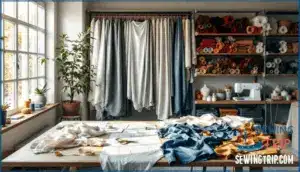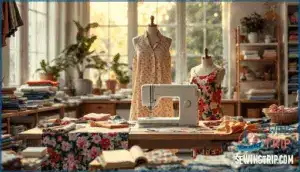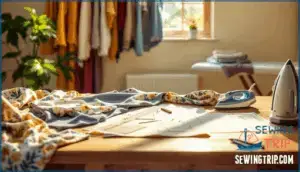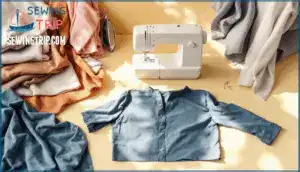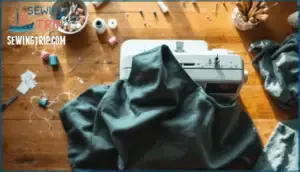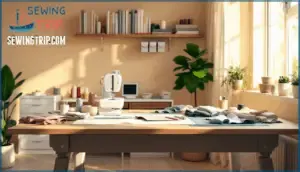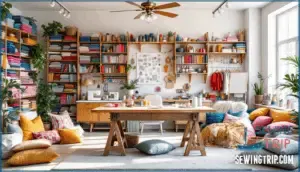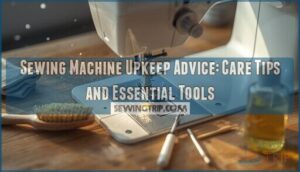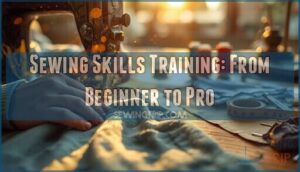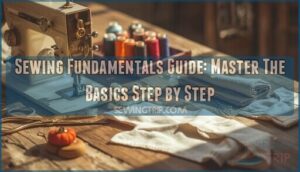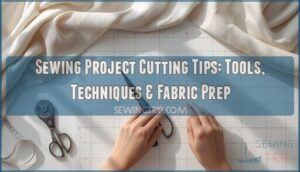This site is supported by our readers. We may earn a commission, at no cost to you, if you purchase through links.
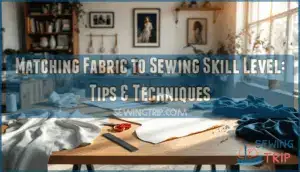
This scene plays out in sewing studios everywhere—aspiring sewers grabbing gorgeous fabrics that demand skills they haven’t built yet. The truth is, matching fabric to sewing skill level isn’t about limiting yourself; it’s about setting yourself up to actually finish projects you’ll love wearing.
When you choose materials that work with your current abilities, you’ll spend less time cursing at your machine and more time developing the techniques that’ll eventually let you conquer those tricky luxury textiles.
Table Of Contents
Key Takeaways
- Choosing fabric that matches your current skill level isn’t limiting—it’s strategic, preventing frustration and helping you actually finish projects while building the techniques needed to eventually tackle luxury textiles.
- Beginners should stick with stable, non-stretch woven cottons like quilting cotton and muslin because they’re forgiving, affordable, and won’t shift during sewing, while slippery silks and shifty knits demand precision that untrained hands haven’t developed yet.
- Pattern matching transforms handmade garments into polished pieces by focusing on visible seams (center fronts, side seams, hemlines) where alignment matters most, while hidden areas can slide—and the right prep work (pressing folds, pinning strategically) matters more than fancy tools.
- Each successful project trains your instincts and sharpens your hands, turning today’s challenging fabrics into tomorrow’s manageable materials faster than jumping straight to difficult textiles ever could.
Assessing Your Sewing Skill Level
Before you pick your next project or grab that gorgeous fabric, you need to know where you stand as a sewer. Your skill level shapes everything from the fabrics you can manage to the techniques you’re ready to tackle.
Let’s break down the main categories so you can figure out exactly where you fit.
Categorizing Sewing Experience (Beginner to Advanced)
Figuring out where you stand as a sewer isn’t about labels—it’s about knowing what you can tackle today and what’ll make you want to throw your machine out the window. Honest skill assessment helps you choose beginner sewing projects that build confidence or expert techniques that stretch your abilities without frustration.
Are you threading your machine for the first time, or confidently sewing curves? Maybe you’re adapting patterns like a pro.
Common Sewing Projects by Skill Level
Once you know where you fit, match that skill level to the right projects. Beginner sewing projects like pillowcases and tote bags—which show up in 92% of beginner resources—build your confidence with straight seams and simple fabric selection. As you nail those beginner sewing techniques, you’ll tackle intermediate sewing skills through fitted skirts with darts or zipper pouches. Each project becomes a stepping stone in your skill progression, teaching garment construction without overwhelming sewing challenges.
- Pillowcases and fabric baskets let you practice foundational seam work in under 30 minutes
- Elastic-waist skirts and scrunchies teach you to manage stretchy fabrics and finishing techniques
- Fitted dresses with zippers bridge the gap when you’re ready for more complex sewing pattern difficulty
- Structured garments demand precision in dart placement and professional seam matching
- Couture projects challenge fewer than 3% of sewers with intricate beading and hand-stitching
For beginners, exploring easy sewing projects can help find the perfect start. The right sewing project selection keeps frustration low and excitement high.
Recognizing When to Level Up Skills
You’ll feel the shift the moment your finished projects start looking more "intentional" than "lucky"—that’s when your hands know something your brain hasn’t admitted yet. Track your sewing skill development through concrete sewing milestones: when you stop ripping seams or confidently adjust pattern difficulty mid-project, you’ve hit mastery goals worth celebrating.
Your hands master the craft before your mind admits it—when seams stop needing fixes and patterns bend to your will, you’ve earned the next level
| Skill Assessment Signal | What It Means | Your Next Move |
|---|---|---|
| Patterns feel too easy | Your sewing proficiency outgrew the instructions | Jump to intermediate skill levels |
| You tweak designs instinctively | Progress tracking shows creative confidence | Try sophisticated garment construction |
| Mistakes don’t derail you | Learning curve flattened—you problem-solve fast | Challenge yourself with couture techniques |
Choosing Fabrics for Every Skill Level
Choosing the right fabric isn’t just about color or pattern—it’s about matching the material to what you can actually manage at your current skill level. Some fabrics are forgiving and easy to work with, while others will fight you every step of the way if you’re not ready for them.
Here’s how to pick fabrics that’ll set you up for success, no matter where you’re in your sewing journey.
Fabrics Ideal for Absolute Beginners
When you’re just starting out with sewing basics, choosing the right fabric types can make or break your confidence. Stick with stable, non-stretch woven cottons—quilting cotton, muslin, and cotton poplin are your best friends.
These beginner materials won’t shift or stretch as you’re learning fabric manipulation and basic sewing techniques. They’re forgiving when you need to rip out seams, affordable for easy projects, and available everywhere. Start here before tackling trickier weaves.
Understanding the different fabric types is essential for selecting the right material for your project.
Best Choices for Confident Beginners
Once you’ve got the hang of basic seams and following a simple pattern, it’s time to explore fabrics with a little more personality—think lightweight linen, chambray, jersey knits, and rayon challis.
These materials let you practice garment finishing and fabric matching techniques without overwhelming your growing sewing skills. You’ll build confidence managing drape and stretch while expanding your beginner projects beyond basic cotton—perfect for pattern adapting as you sharpen your sewing techniques.
Intermediate-Friendly Fabrics
At the intermediate level, you’re ready to tackle fabrics that demand a bit more finesse—denim, ponte knit, corduroy, wool blends, and fabrics with directional prints or nap.
These materials push your sewing skills further as you learn to manage weave texture, fiber blends, and fabric drape with intention.
You’ll start considering print scaling and color palettes when planning a sewing project, applying sewing techniques that transform your work from simply “finished” to genuinely polished.
Advanced and Couture Fabric Options
When you’re ready for luxury fabric trends like moiré silk, Chantilly lace, or hand-embroidered French guipure, you’ve reached the domain of couture. Sophisticated sewing projects demand exclusive textiles—think beaded fabrics, feather materials, and sustainable couture innovations like vicuña or banana fiber.
These sophisticated materials require specialized couture techniques and precision in textile design, pattern making, and fabric selection. Silk captured 24.5% of the luxury market in 2023, proving its enduring appeal for sewers pursuing truly outstanding garment construction.
Matching Fabric Prints and Patterns
When you’re working with fabric that has a visible design, matching patterns at the seams separates handmade from homemade. It’s not always necessary, but knowing when and how to match can transform your project from amateur to polished.
Let’s walk through the essentials—what you need, how to tackle different prints, and how to manage your fabric wisely along the way.
Basics of Pattern and Seam Matching
Pattern matching isn’t about making every seam line up perfectly—it’s about knowing which seams actually matter and how to fake the rest when you need to.
Seam alignment starts with understanding fabric grain and pattern repeat. When you’re matching fabric design across pattern pieces, focus on visible seams first—center fronts, side seams, hemlines.
Precision cutting and proper seam matching create that polished look, while hidden areas can slide.
Tools for Accurate Fabric Matching
You don’t need fancy gadgets to match fabric—just a few everyday tools and a little patience will get you there. Grab fabric markers for marking pattern pieces, straight pins to hold everything steady, and a good ruler or seam guide for measuring repeat distances.
Ironing tools are non-negotiable—pressing creates sharp folds that act like roadmaps for seam matching and pattern alignment.
Tips for Matching Plaids, Stripes, and Prints
Matching fabric prints and stripe alignment can feel like solving a puzzle, but once you crack the code, your garments will look store-bought in the best way. Start with symmetrical stripes—they’re forgiving since you can flip pattern pieces and still achieve seam accuracy. Wider plaids are easier than tiny checks because you’ve got fewer match points to juggle.
Always match at seamlines, not cutting edges, and prioritize center fronts, side seams, and any spot people will actually see.
For print placement on bold motifs, avoid landing dominant elements right at your bust or hip line—shift things around until the design flatters rather than fights you.
Managing Fabric Waste and Pattern Repeat
Here’s the catch about matching patterns: even when you do everything right, you’ll still end up with more fabric waste than a standard layout would create. Pattern repeat size dictates your yardage—buy extra based on the repeat measurement, not just your pattern pieces.
For waste reduction, arrange pattern pieces to share seamlines where fabric design aligns, and save scraps for pockets or facings. Think sustainable sewing and fabric efficiency combined.
Step-by-Step Fabric Matching Techniques
Once you’ve got your fabric matched up and your pattern pieces laid out, the real work begins—getting those seams to line up perfectly.
The process breaks down into four key stages that’ll take you from rough alignment to polished results. Here’s how to work through each step so your matched seams look like they were meant to be together.
Preparing and Marking Fabric for Matching
Before your scissors ever touch the cloth, a little prep work can save you from that sinking feeling when prints don’t line up at the seams. Start by centering your fabric design—fold it horizontally and watch how the pattern repeats. Here’s what you’ll need for successful pattern matching:
- Fabric pen – Mark notches without second-guessing
- Ruler – Measure repeats like you mean it
- Straight pins – Hold everything steady during fabric cutting
- Iron – Press folds for seam alignment guidance
- Your pattern piece – Position deliberately for print matching
This matching fabric design approach transforms fabric preparation into confident, accurate work.
Pinning and Pressing Seams for Precision
Once your fabric is marked and positioned, the real magic happens when you press those folds and pin with intention—this is where guesswork ends and sharp alignment begins.
Press a fold along each stitching line using a hot iron—crisp folds act as your matching roadmap. Then pin side seams with straight pins perpendicular to the seam allowance, catching both layers exactly where patterns intersect. This pinning technique locks fabric stability in place, guaranteeing seam accuracy before you ever touch the pedal.
Techniques for Tricky Garment Areas
Collars, princess seams, and bias-cut edges won’t play nice with your standard matching moves—they curve, twist, and shift in ways that demand a little extra finesse. Here’s how to keep seam alignment steady during tricky garment construction:
- Clip curves along the seam allowance before pinning—this releases tension and lets fabric lie flat for collar matching and curve sewing.
- Stay-stitch bias-cut pieces immediately after cutting to prevent stretching during garment construction techniques.
- Match at key intersections only (notches, center points) rather than forcing every inch to align on curved seams.
- Press as you go—constant heat-setting helps control fabric behavior in complex sewing project instructions.
Using Notions and Machines for Better Results
The right tools can turn a wobbly seam match into a bulletproof alignment—and sometimes it’s your machine settings, not your skills, that make all the difference. Swap your all-purpose foot for a 1⁄4-inch foot when precision matters most.
A walking foot grips layers evenly during garment construction, preventing shifts in stripes or plaids.
Invest in fabric cutting tools like rotary cutters for cleaner edges. Use interfacing techniques to stabilize stretchy fabrics before you match patterns—it’s a key to success for sewing techniques that demand control.
Elevating Garment Construction Skills
Once you’ve got the basics down, it’s time to push your skills further and create garments that really stand out.
The next step is choosing the right projects, thinking strategically about design, and adding those finishing touches that make your work look store-bought.
Here’s how to take your sewing from good to great.
Selecting Projects to Practice Matching
Start small with projects that have a forgiving margin of error—think simple pouches or straight-seamed tote bags where you can build your confidence without the pressure of creating a showpiece.
As your sewing skills sharpen, move on to garments with clear seam alignment challenges—like A-line skirts with side seams or basic shift dresses. These projects let you practice pattern repeat awareness and fabric selection without wrestling with curves or complicated garment design right away.
Incorporating Pattern Matching Into Garment Design
When you’re ready to think beyond just lining up seams, pattern matching becomes a design choice that can either highlight or hide the structure of your garment. Think strategically about where matched seams will draw the eye—and where they won’t matter much:
- Center front seams on button-up shirts deserve your attention for symmetry
- Side seams matter less since they wrap around the body
- Sleeve caps can be nearly impossible to match perfectly—and that’s okay
- Hemlines showcase your skills when the pattern repeat aligns beautifully
- Princess seams require patience but create stunning visual flow when matched
Your fabric layout and textile selection directly influence garment silhouette, so use pattern markings to plan seam alignment before cutting.
Advanced Tips for Professional Finishes
Achieving professional finishes means going beyond basic construction—it’s where sophisticated sewing projects truly shine. Master seam finishing techniques like Hong Kong binding or French seams to eliminate raw edges. Choose garment interfacing thoughtfully; it stabilizes collars and cuffs while maintaining drape.
Professional trims and couture details—think hand-picked zippers or bound buttonholes—separate homemade from handmade. Pattern alteration techniques guarantee your fabric selection complements body contours, while sewing techniques knowledge helps you press as you go, creating that coveted professional finish that looks expensive and intentional.
Frequently Asked Questions (FAQs)
How does fabric drape affect sewing difficulty?
Drape—how fabric flows and falls—changes everything. Stiff textiles hold their shape, making them forgiving for beginners.
Fluid fabrics shift constantly, demanding control over fabric weight and texture impact, turning simple sewing techniques into precision work requiring serious textile knowledge.
What fabrics should beginners avoid and why?
Steer clear of slippery silks, shifty knits, and see-through sheers—these textile choices demand precision your beginner sewing skills haven’t mastered yet.
Fabric suitability matters because sewing challenges multiply with tricky materials.
When should you pre-wash fabric before matching?
Pre-wash fabric before matching to prevent fabric shrinkage and color bleeding later. This fabric preparation step guarantees fabric stability, giving accurate measurements for sewing techniques.
Most fabric types benefit from pre-wash—your sewing skills improve when working with clean, stable material.
How do fabric weights impact pattern matching?
Heavier fabric types hold their shape differently than lightweight ones, which changes how your pattern repeat lines up at seams. Thick fabrics resist manipulation, making precise matching trickier, while drapey fabrics shift easily—you’ll need adjusted seam allowance and thread tension to keep fabric design aligned perfectly.
Can you mix fabric types in one garment?
Yes, you can mix fabric types in one garment. Textile mixing and garment layering work well when you pair fabrics with similar care needs.
Try combining woven fabrics with knit fabrics for hybrid designs, or blend complementary textures for mixed media effects.
Conclusion
Think of matching fabric to sewing skill level like learning to drive—you don’t start with a manual transmission sports car in downtown traffic. Those slippery silks and temperamental knits will still be waiting when you’ve built your confidence on stable cottons and forgiving linens.
Each successful project trains your hands and sharpens your instincts, turning today’s challenging fabrics into tomorrow’s manageable materials. Choose fabrics that let you practice without frustration, and you’ll find yourself conquering those dream textiles faster than you imagined possible.
- https://www.brewersewing.com/search.aspx?ctl00$Search$SearchBox=wash%20away%20wonder%20tape
- http://sewing.patternreview.com/cgi-bin/profile.pl?profileid=184300
- https://www.pinterest.com/ageberry/
- https://www.longancraft.com/blogs/sewing-tips/what-is-the-first-thing-a-beginner-should-sew
- https://www.positivelysplendid.com/easy-sewing-projects-for-beginners/

